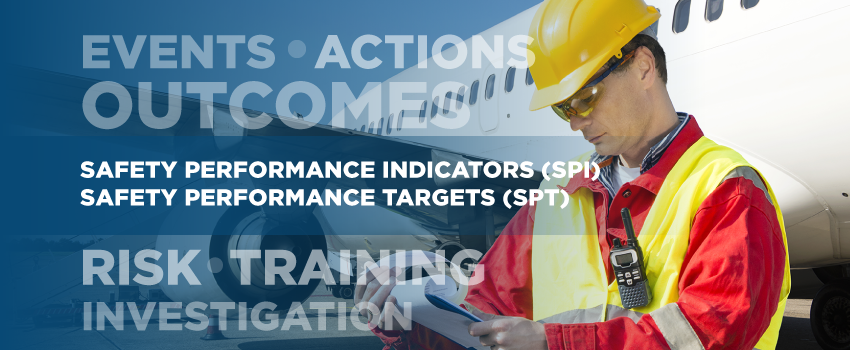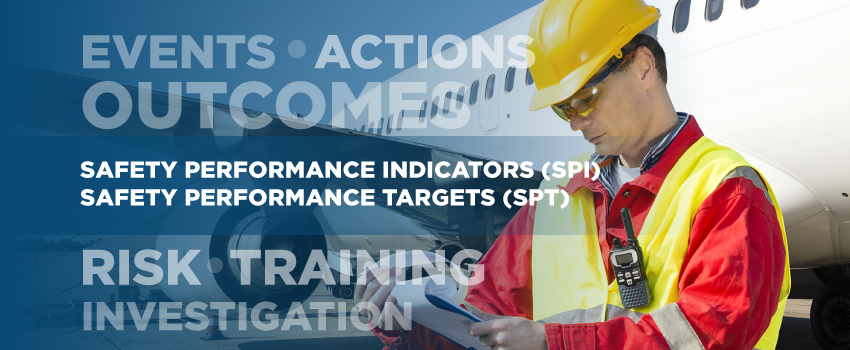
In order to support a constructive safety management system, it is important that an organisation identifies and monitors SPIs and SPTs that will make for a safer airline. An example is provided below which shows how a safety management objective is monitored using SPIs and SPTs.
An organisation has identified that they are experiencing an increased number of altitude busts and are falling well below the national, average figures as published by their NAA. It is believed that this issue is partially the result of poor flying techniques and also an increased number of aircraft dispatched with the autopilot disabled (as allowed for in the MEL).
To address these issues, the company have initiated a pilot training program (both classroom and simulator based) and also, a temporary restriction has been imposed in the MEL that only allows dispatch with the autopilot disabled for non-training flights. Management have set a SMART safety objective to reduce the rate of altitude busts per 10,000 flights from 50 to 12 in the next 18 months.

To monitor progress towards this safety objective, a SPI of “altitude busts per 10,000 flights” has been set. In addition, it is expected that the simulator program will have the greatest, positive impact on this issue and this should be completed in 6 months; therefore, the greatest reduction in altitude busts should occur in the first half year. As time progresses the reduction rate will reduce until the final target is met. For this reason, SPTs are set to reflect a greater rate of achievement in the first six months. This process is shown graphically in figure 1 below:

In the diagram above, the lagging SPI is the rate of altitude busts. The safety objective is to achieve a rate per 10,000 flights of 12 in 18 months. To reflect the increased rate of improvement in the first 6 months, SPT A1 is set at 30 after 6 months thereafter, 20 after 12 months and finally, 12 after 18 months. By monitoring the actual rate of altitude busts, the safety team and management can monitor easily the progress being made to achieve the objective. Furthermore, they can use this information to demonstrate to their regulator that they have indeed made progress and are on track to achieve their stated safety objective.
As a further embellishment, the company could establish a leading SPI for the above case by recording the number of pilots who have received the classroom and simulator training. A final lagging SPI could be the number of times that aircraft are dispatched with the autopilot disabled (a precursor event).
Considerations for selecting SPIs and SPTs
The above example demonstrates the value and practicality of using appropriate SPIs and their associated targets. However, care must be taken when selecting your SPIs and SPTs. It would be very easy to overload the system with countless indicators and targets that, in reality, are not aligned to your safety objectives and do not contribute towards your safety oversight. The following issues should be considered when selecting your SPIs and their targets:
- Workload management. Creating a workable amount of SPIs can help safety personnel manage their monitoring and reporting workload. The same is true of the SPI’s complexity, or the availability of the necessary data. It is better to agree on what is feasible, and then prioritise the selection of SPIs on this basis. If an SPI is no longer informing safety performance, or been given a lower priority, consider discontinuing in favour of a more useful or higher priority indicator
.
- Optimal spread of SPIs. A combination of SPIs that encompass the focus areas will help gain an insight to the organisation’s overall safety performance and enable data-driven decision-making.
- Clarity of SPIs. When selecting an SPI, it should be clear what is being measured and how often. SPIs with clear definitions aid understanding of results, avoid misinterpretation, and allow meaningful comparisons over time.
- Encouraging desired behaviour. SPTs can change behaviours and contribute to desired outcomes. This is especially relevant if achievement of the target is linked to organisational rewards; such as management remuneration. SPTs should foster positive organisational and individual behaviours that deliberately result in defensible decisions and safety performance improvement. It is equally important to consider the potential unintended behaviours when selecting SPIs and SPTs. This could result in a somewhat “blinkered” approach to safety management with the primary focus being only on the achievement of specific targets rather than taking a more holistic view of the overall safety performance throughout the organisation.
- Choosing valuable measures. It is imperative that useful SPIs are selected, not only ones which are easy to measure. It should be up to the organisation to decide what the most useful safety parameters are; those that guide the organisation to improve decision-making, safety performance management, and achievement of its safety objectives.
- Achieving SPTs. This is a particularly important consideration which is linked to the desired safety behaviours. Achieving the agreed SPTs is not always indicative of safety performance improvement. The organisation should distinguish between just meeting SPTs and actual, demonstrable organisational safety performance improvement. It is imperative that the organisation consider the context within which the target was achieved, rather than looking at an SPT in isolation. Recognition for overall improvement in safety performance, rather than an individual SPT achievement, will foster desirable organisational behaviours and encourage exchange of safety information that lies at the heart of both SRM and safety assurance. This could also enhance the relationship between the State and the service provider and their willingness to share safety data and ideas.
Providing that you select your SPIs carefully, they will provide your organisation with a wealth of reliable data and useful information. Using this safety information, decision makers can make informed and defensible data-driven decisions that will help to improve continuously your SMS.
To support your SPI dashboard consideration must be given to ensure that right safety management system software is in place. A supported SMS software solution will help safety managers obtain information and data that can support their respective SPIs and SPTs; and it will result in a safer airline organisation.
Learn how the right safety management software can help support your airline’s safety investigation, risk and audit management and compliance solutions. Download our free guide to find out how to select one that benefits your airline.
Note: Information in this article is taken from ICAO Document 9859.
Image by Corepics VOF (Dreamstime)



